The following post is a part of the “Kailash Mansarovar Yatra” Blog Series Into the Sacred Space. To read complete travel memoirs and trip report, please visit here.
After returning to the camp house at Darchen, I headed out in search of a hot water bath. The emerging village of Darchen has quite a few such setups, run on solar energy by enterprising locals, where hot water shower bath is actually a possibility. The lady charged 10 RMB for a nearly unlimited bath; a thing of luxury I’d say. The weather had totally cleared up. From a distance, the waters of Rakshastal appeared like a turquoise tray beneath the gigantic Gurla.

The Kailash beyond the waves of brown-purple foothills; up here, the distances are greater than they seem. Landmarks look closer and smaller than they actually are. More images at Flickr
Our next halt, an hour’s drive from Darchen, was at Qugu monastery, also known by Trugo or Chugu, located by the Southern shore of Mansarovar. After days of travelling and trekking, we were finally going to be at the serene Mansarovar. The weather advantage was on our side as we left Darchen. Cruising on the highway, our vehicles briefly halted at Barkha where we topped up our rations and veggies. A few of us bought large-sized plastic bottles to carry the sacred water back home. Prayer flags were festooned in all directions; ancient chortens, mane stones, flagpoles et alia. Modern nomadic herders dotted the eastern shoreline. Completing a clockwise circuit of the flagpole at Hor Qu reception centre, we reached the Qugu monastery built on a raised level-ground by the sacred lake.
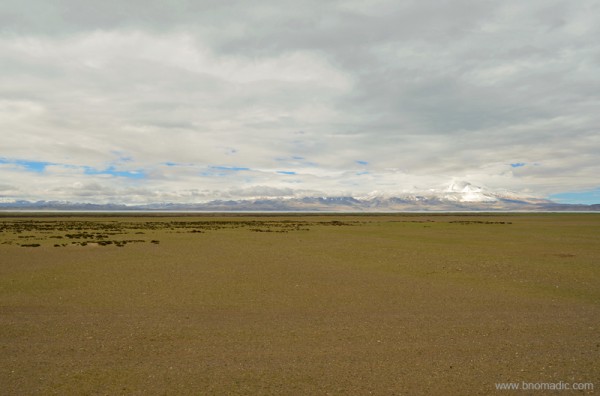
Miles away from the eastern shore, the Gurla Mandhata silvers the water. For more images, visit Flickr
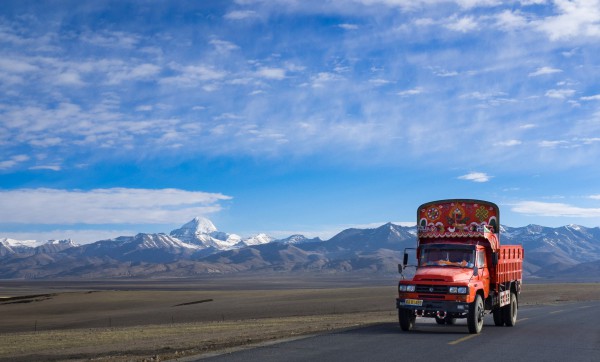
Western Tibet is remote, rugged, windy, and cold. It is much more rural than Central and Eastern Tibet. Photo and Caption by Rita Willaert

The rare Black-necked Crane; had spotted many such couples near Barkha village. Photo by Jen Reurink
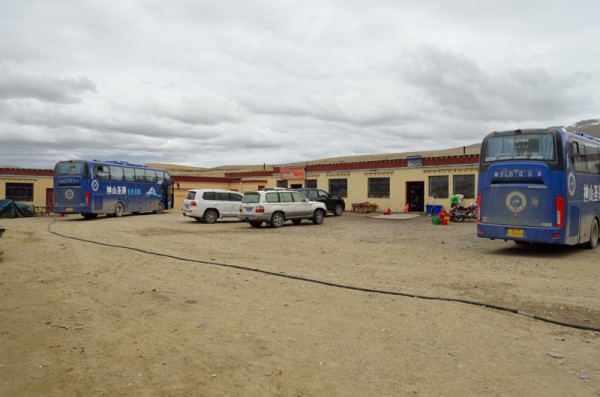
The guesthouse compound at Qugu. More pics from the region/ yatra at Flickr Photoset
It was comfortably warm inside the dormitory of the Qugu camp house where the room had the most iconic vistas – the Kailash Mansarovar – right from the windowpanes itself. Outside, it was cold with the temperature dropping further; every time a cloud passed overhead. Grabbing a cup of hot tea and later having reassembled my luggage, I headed out for a walk along the shoreline. The lake is far wider and larger than I had imagined it to be from the photographs and numerous descriptions. The lake turns turquoise from dark blue as the drifting clouds make way for the sun. Shining fifty miles away in solitude, the Kailash is clearly visible. From a distance, its chiselled south face creates the illusion of a long, vertical stairway, as if for Gods to climb by. Although void of any life, as if carrying the marks of some sacred prehistory, the Mansarovar with its sapphire-blue waters, sandy shoreline against a backdrop of snow-capped mountains is wholly appealing. We seemed to have entered the holy land.
As I sit by the lake watching flocks of geese, crested grebes, mergansers, gulls and some other waders bobbing on the blue waters; in smaller groups, yatris huddle together after having completed the ritual bath; performing yagya and group poojas along the shoreline and bursting into loud holy cries. The lake contains several varieties of fish, carp and scale-less loaches on which these birds that winters in Indian plains, feed. The mythology equates these birds to Shiva’s swan that is said to nest on its shores. I revered in deep respect for the earlier travellers and adventurers who explored and surveyed this region; including the eminent ornithologist Dr Salim Ali who took a first of its kind expedition in 1945 to Mansarovar and behaviourally studied different species of this region.
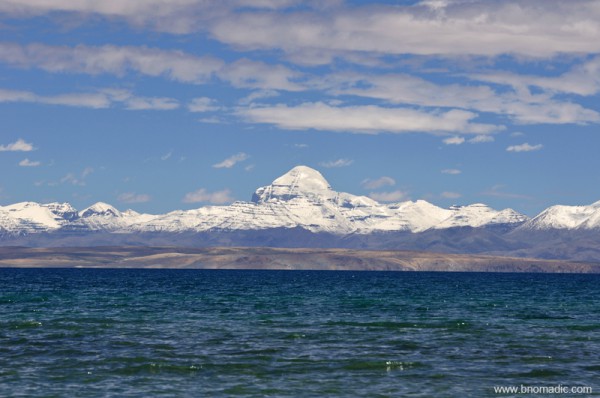
The Kailash and the still Manasarovar; the quietness itself seems to freeze the water. More images at Flickr

A Brown-headed Gull in its breeding plumage; their solitary notes only accentuate the silence. More at Flickr

The Qugu monastery and the guesthouse; the same spot where the legendary explorer Sven Hedin had camped more than a century before. Please visit Flickr for more images of the region or yatra

A Tibetan pilgrim collecting pebbles. Please visit Flickr Photoset for more images of the region

A Lesser Sand Plover in its breeding plumage. More images from the region at Flickr Photoset

A Blanford’s Snowfinch or Plain-backed Snowfinch. More images from the region at Flickr Photoset

Taking a stroll along the shoreline and collecting pebbles. More images at Flickr Photoset
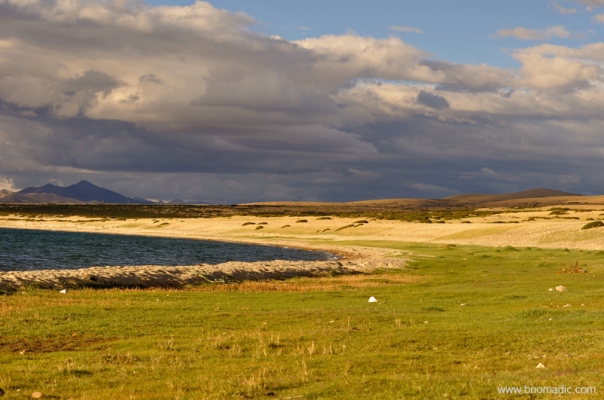
The shoreline glittering in the evening sun; all along the shore, between the blues and the greens, waders thrive in fullness. More at Flickr
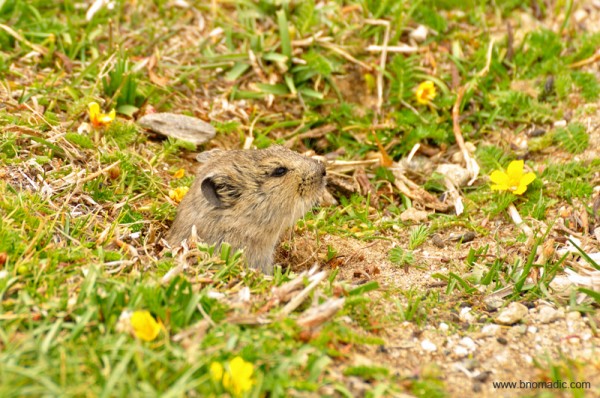
A Stoliczka’s Mountain Vole. Please visit Flickr Photoset for more images from the region and yatra
Apart from its spiritual significance, the region has also been famous for its yield of gold and turquoise; though most of the mines in the surrounding hills now stand abandoned. The region brought many curious western explorers; including game lovers William Moorcraft, Hyder Hearsey, explorers Sven Hedin and the pundit surveyors. Its most famous pilgrim Swami Pranavananda visited the region more than ten times and carried out scientific surveys as well as collected data and penned multiple guidebooks. The clear blue waters of the Mansarovar, highest freshwater lake of this sheer size in the world have been associated with mythologies of different faiths and religions. Tibetans, who call it Mapam Tso, commemorate the lake to Milarepa’s victory over a Bon shaman. The followers of Buddhism are also of the view that Buddha’s mother Maya bathed in this lake before conceiving him. Hindus believe that Mansarovar was the divine imagination of Brahma; before it became a geographical reality. As also is the belief that those who bathe in the sacred waters of the lake, where Gods dip; get cleansed of all sins from past as well as future life.
I wade in about 10m from the shore and as the water reaches my knees, I take five dips. The glacial melt of Mansarovar is not as cold as I expect it to be. Not sure if it cleansed my body but it calmed my soul for sure; giving it the warmth it needed. Faith argues that there exist hot springs inside the lake, even though; it remains frozen for more than eight months of the year. For the next couple of days, our activities were simple yet most fulfilling in this quiet natural sanctuary; sky gazing, long walks, collecting pebbles, clicking photographs, counting birds, meditating and performing poojas of course.
Picking up a handful of pebbles from the shore to take home as sacred mementoes, I make for the Qugu monastery (4590m), the traditional bathing place for Hindus before 1959. Being traditional overnight halt on the Mansarovar circuit as also for the basic guesthouses built adjacently; Qugu along with Chiu gompa still continue to be the most active pilgrimage sites around the lake. Just as the seven other monasteries built equidistant around the lake, symbolising a spoke of Buddhist Wheel of Life; Qugu was also gutted in the Cultural Revolution. Even though, with the onset of international tourism, a few of these devastated monasteries have been restored but they could never be as populous.

In this beauteous air I felt oddly exhilarated. Please visit Flickr Photoset for more images of the region

Qugu gompa (4590m) is the largest of the monastic sites around Mansarovar and was originally founded as a site for Drukpa Kargyupa mediators. More images at Flickr Photoset

Inside the monastery that was earlier handed over to Shepeling, a large Gelukpa monastery now in ruins on a ridge above Purang (Taklakot). More images at Flickr
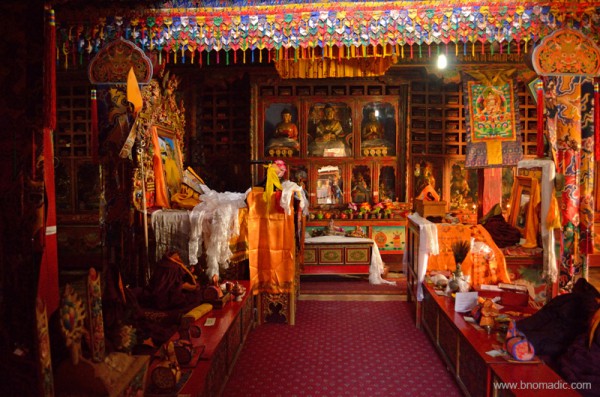
The central three figures in the assembly hall are Dusum Sangye – the Buddhas of the Three Times. Many of the smaller statues here were brought from Shepeling. More images at Flickr
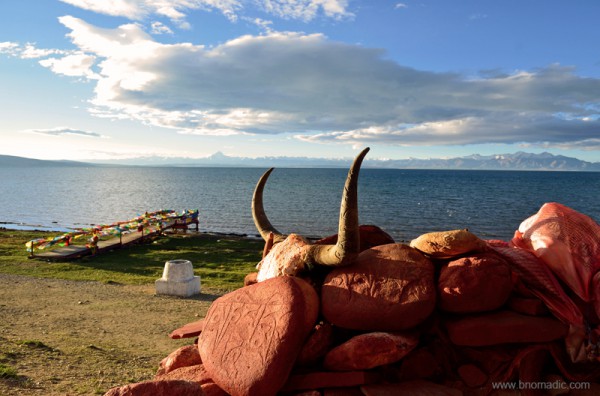
The rare natural colours that matter here are brown-earth, snowy white, sky and its reflection plus some occasional patches of greens. Everything else, including those of the prayer flags are a creation of mankind.

A Horned Lark. Please visit Flickr Photoset for more images of the region or yatra
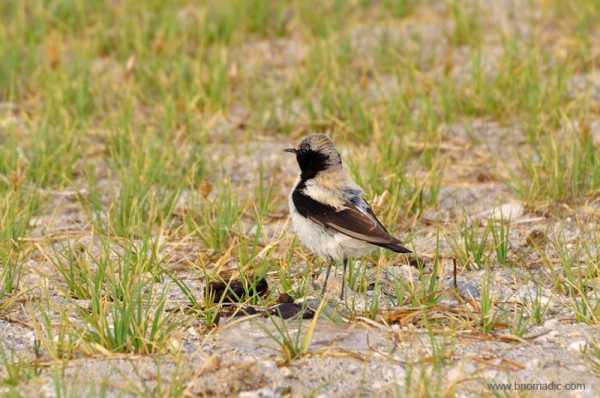
A Desert Wheatear. Please visit Flickr Photoset for more images of the region or yatra
For two days, irrespective of the weather I ramble on along the shore; with a camera in hand resting only at night or for meals. At over 4500m, with the air being light, my heart beats faster but my feet are aware where they are stepping. Up there, the sun burns with a cleansing brilliance. The sands are whitish and soft underfoot. As the cold wind would rise every now and then, the miniature waves too would respond proportionately. Fenced by snowy range, the holiest of the earth’s lakes – the Mansarovar – with its two hundred square miles of water, stretches endlessly with unfathomable azure. The rare natural colours that matter here are brown-earth, snowy white, sky and its reflection plus some occasional patches of greens. Everything else, including those of the prayer flags are a creation of mankind.

Lunching at the guesthouse. Please visit Flickr for more images of the region

Chinese military encampment behind the monastery. More images at Flickr Photoset
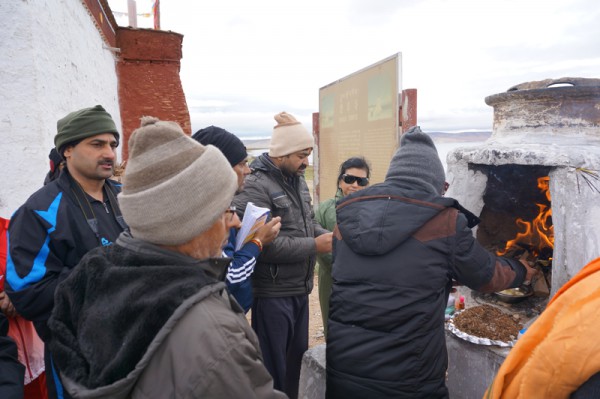
Evening pooja at Qugu. Please visit Flickr Photoset for more images from the region or yatra

MP Tarun Vijay and his wife joins for the evening aarti at the guesthouse. More images at Flickr Photoset
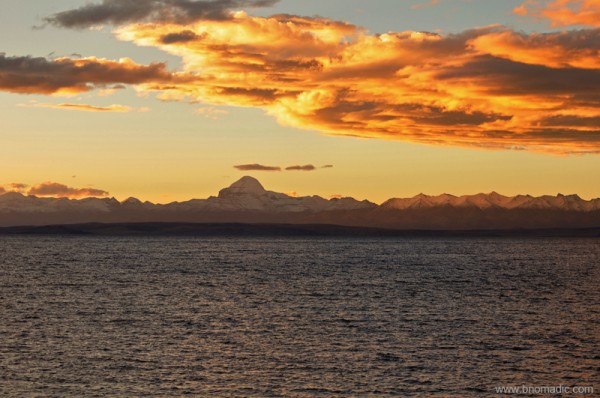
The sacred view in the evening; the region has an intriguing geology for Mansarovar is a stranded fragment of the Tethys Sea, almost drained by the upthrust of the Himalayas. More images at Flickr
We are not bothered by the timing and quality of the food that is being served to us by the cooks. The excitement of staying so close to the sacred spectacle doesn’t let us sleep. Our gazes are ceaselessly fixed in the northern direction. At night when the clouds disperse, we are treated to the most spectacular display of stars. Many of us step outside of the dormitory to see the sky more clearly in a widest of high-altitude theatres. The faint profile of the snow-laden peaks is very much comprehensible in a moonless night. A few of us claim to have seen lights descending from the sky into the waters. Someone from the group asserts that these are deities in the form of light who descend to bathe in the lake, which is why it is sacred. Almost all of us agree with full devotion. Now whether it is St Elmo’s fire or something else, pilgrims are delighted to have seen it. I got up early in anticipation of another extraordinary view but was greeted with murky dawn and overcast sky on both mornings.
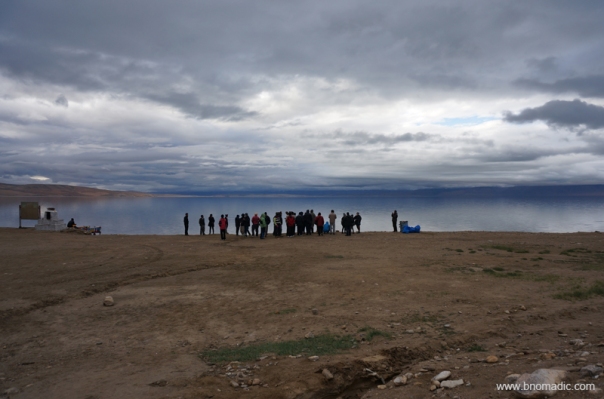
Early morning at the Mansarovar. Please visit Flickr Photoset for more images of the region or yatra

We took advantage of the time and cleaned up the shore. More images at Flickr Photoset

A Tibetan Woolly Hare; Descriptions recall that visitors encountered bands of wild animals in the region – I too glimpsed many particularly shy marmots and hares. Photo by Jen Reurink
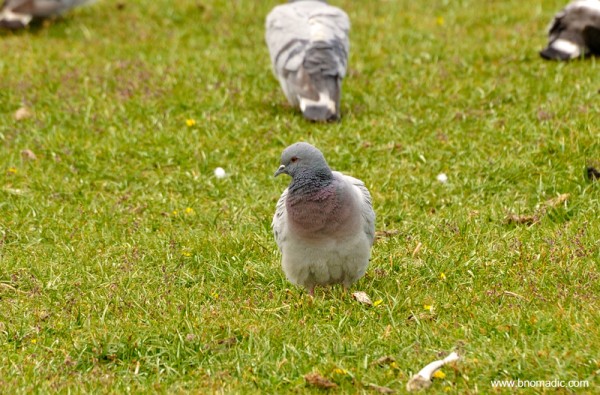
A Hill Pigeon. Please visit Flickr Photoset for more images from the region
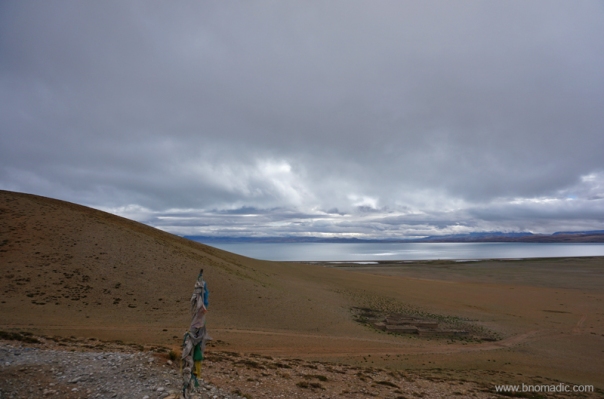
Ruined and deserted structures by the Mansarovar as observed from the bluff. More images at Flickr

The irregularly shaped Rakshastal is about 15m lower in altitude than Mansarovar. “Rakshas” means demon and this lake is associated with evil forces as per Hindu mythology. Photo by Aarti Saxena
Having spent two days at the site, as per the itinerary, we wrapped up our Mansarovar yatra by completing a parikrama of the lake in a clockwise direction. As we continue circling the lake passing a few deserted monasteries or shelters, we climb a ridge and reassemble by a cairn of rocks from where a near dramatic view of the Manasarovar as well as the Rakshastal, on the other side, could be obtained. Ahead, we crossed the historic Chiu Gompa as well as the channel that connects Mansarovar with Rakshastal before we assemble at the reception centre at Hor Qu to board our buses.
 bNomadic
bNomadic
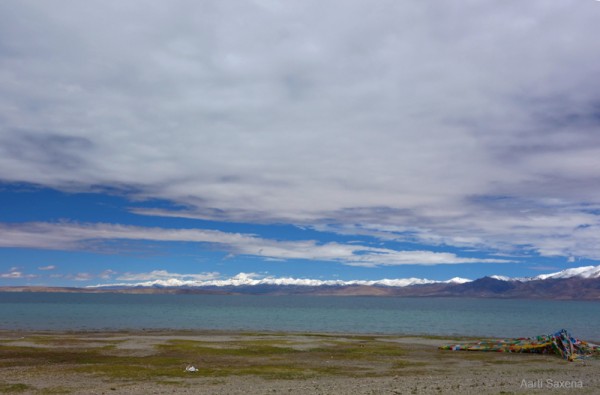




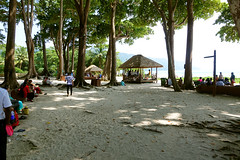






Pingback: The Kailash and the Yam Dwar | bNomadic
Pingback: Into the Sacred Space | bNomadic
So lucky you!
Great pics from the place. Hope to visit some day!
Absolutely! V Lucky indeed. Glad you liked the photographs. Keep visiting bNomadic 🙂
Classic post with some great and lovely pics.. Really a nice place to be visit…
Thanks admin:-)
Beautiful pics.
Thanks 🙂 Visit more often:-)
Thank you so much for sharing your journey and photographs, it’s a rare treat. 🙂
Thanks Shellie for stopping by the blog. Glad you liked it. Keep visiting bNomadic 🙂
I am following. 🙂
बहुत सुन्दर,
मै स्वंम भी इस यात्रा मे साथ ही था
धन्यवाद नौरतमल जी! जी बिल्कुल सही फ़रमाया। पढ़ते रहिएगा bnomadic
अति सुन्दर ,
इस यात्रा मे मै स्वंम भी सामील था।
Your pictures are beautiful as always
Thanks Bilal! Keep visiting bNomadic and keep showering your love 🙂
Nice Post and awesome photos 🙂
Thanks Vishal! Keep visiting bNomadic for more such travel stories and photographs 🙂
I have always wanted to see Mansorovar but I doubt I will be able to acclimatise now. Well, at least I got a beautiful glimpse through your post and breathtaking pictures:)
Thanks for stopping by the blog! Acclimatisation should not be a problem as long as you are mentally prepared for it. I am glad you liked the description. Keep visiting bNomadic for more such travel stories:-)
superb pics.. seems you do really meet eternity 🙂
Absolutely! (and still in that mode) Thanks for dropping by the blog! Visit bNomadic more often:-)
Stunning photographs and a great writeup as usual. Keep going. All the best.
Thanks! Glad you liked it. Keep visiting bNomadic 🙂
Magnificent captures!
Thanks! Keep visiting bNomadic 🙂
satyendra,I am glad to see your photo of yatra,and your details about our journey and stay with you. Ashwini Ghosh
Thank You Sir! Hope you are doing fine. Aaashirwaad hai aapka! Glad you liked the post. Keep visiting bNomadic for more such travel stories:-)
Great Pictures.
Thanks! Keep visiting bNomadic for more 🙂
Hey , love the your blog.
I am glad that I discover you. I hope we can help each other. i just followed your blog ❤
Do have a look @my blog.
Love.
xoxo
Thanks for dropping by the blog. Sure, looking forward. Keep visiting bNomadic 🙂
Superbly written and well traversed! Excellent collection of Pics!
Thanks Mr Kaul for stopping by and for the appreciation. Keep visiting bNomadic for more such travel stories 🙂
I’ve always had that journey on my “list,” good to see it through your eyes
Thanks nomadruss for stopping by the blog. Glad you liked it. Hope you’d find it useful as well. Keep visiting bNomadic for more such travel stories 🙂
Thanks nomadruss for stopping by the blog. Glad you liked it. Hope you’d find it useful as well. Keep visiting bNomadic for more such travel stories 🙂
Lovely photos! It felt like I was there! Thanks for sharing 🙂
Thanks for dropping by the blog and appreciation. Keep visiting bNomadic for more such travel stories 🙂
Wonderful Satyendra
You recreated whole Yatra permanently.
God bless you-
Dr Sunil & Dr Trishala
Thanks Sir! I am glad the post rekindled yatra memories. Keep visiting bNomadic 🙂
Pingback: Retracing the Trade Route to Nathula | bNomadic
Nice narrative.
Thanks! Keep visiting bNomadic 🙂